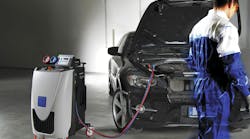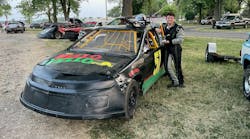DETROIT — There is technology out there that is so surprising, it even helps reduce surprises. And start a car. And track driving habits. And play your favorite music. And so much more.
The idea of telematics has been around long enough now that most shops at least are familiar with the idea and basics of what is offered on today’s vehicles. But what is out there today is just the start, and there is much more coming down the pike quickly, as a group of industry leaders from the automakers and government organizations discussed at CARS 2014.
The number of vehicles with factory-installed telematics is expected to increase from 10 percent now to 62 percent in 2016, and Steve Coker, head Uconnect Operations, Chrysler Group LLC, adds that the connected vehicle has gone through an interesting transformation over the last few years, especially in the last 18 months. The biggest influence has been the smartphone. “Everything starts and ends with our customers, and increasingly their life includes (their smartphone),” he notes.
While “customers are used to being connected where they’re at: they’re connect at home, they’re connect at work and they connected when they walk around,” Coker continues, the overarching view of the panelists is that customers also want to be safe.
Eric Berkobin, vice president, engineering, Verizon Telematics, explains that collision avoidance, automatic braking, etc., are at the top of the list of customer wants on new vehicles. They also like vehicle health reports, he offers, as that information makes a customer feel empowered.
Bob Stewart, general manager, customer care and aftersales, ACDelco/General Motors, echoes the statement, noting that, “it’s really the safety and security features that consumers want.”
Coker does note that while his customers do value safety and security, mostly it’s a feature that they don’t always see in play and don’t think about it. Most often, Chrysler sees customers using their smartphone to remote start their cars, a nice feature of convenience that customers like.
“It’s important to understand what the customers use every day,” he states. “It really comes down to what do the customers like to make their lives easier and experience more comfortable.”
At Volkswagen, it’s safety first, says Frank Weith, general manager, Volkswagen Group of America. The carmaker works to integrate systems to keep the consumer safe when there are other factors like the consumer electronics industry coming into the vehicle.
Then there is the National Highway Traffic Safety Administration, which Roger Saul, director, vehicle research and test center at NHTSA, says has a riding interest in reducing traffic injuries and fatalities. The other big area is automated driving, and there is a lot of overlap between that and the technology available now and coming soon, he says.
The automotive industry has had some of this for a while, including adaptive cruise control, Saul adds. In the connected vehicle, there is an ability to augment the technology there now in radar with radio frequency that will allow cars to see around corners and be able to be more predictive of crashes and give more time to prepare for them.
But What About the Data?
All of the connectivity and customers’ wishes to be kept safe adds up to a lot of data, something shops, engineers and automakers as a whole have been well aware of nearly since the starts of telematics.
“There is big data available,” says Jules Polonetsky, executive director, Future of Privacy Forum. “There’s all this data being collected and there’s value in that data.”
This information is relevant to today’s shops as to how the vehicle is being driven, while insurers want to know how the driver drives and the fleet operators want to know where the drivers are. The diagnostic data is actionable, and can be provided to the consumer.
“We’re not diagnosing vehicles, what we’re really doing is getting you qualified leads. Maybe when we send an email to them, we send an email to you,” Polonetsky states. “You can work your bays more like restaurant tables and be more efficient.”
He feels that it is critical for policy makers to realize this is new and evolving, so they need to learn about it. “We’re still at a point where we need to make sure we do these things in a sober and realistic way.”
Verizon Technologies strives to help customers and institutions understand that there is data that will be useful and there will be touch points that will need access to the data to make the system work well.
“The challenge for all of us in this ecosystem…the biggest advantage that we all have here is that 99.99 percent of what everybody is trying to do here is safety service for people,” Polonetsky says, adding that there is a huge opportunity to lean into data use and not be scared that it’s big data.
From the automaker’s standpoint, it also is important to educate the consumer about this data.
“The most important thing is that as these features in vehicles roll out more and more the customers feel empowered and confident in these features.. We’ve seen in the past where customers have retracted from it.,” says Alan Prescott, the connectivity attorney for Ford Motor Company. “It’s really important that we have an educated customer…that they realize the benefits of it.”
Many customers also probably realize the potential pitfalls of hacking and stealing of the data, which all panelists said they are focusing on. Weith says there will be a cost for the OEs to make sure that any of this technology, including an embedded module, is secure. That’s especially true, as an embedded module could be the best way to keep a car safe.
In the end, Saul says NHTSA recognizes that too, and works to not pick winners and losers in this race to development, but rather focus on enforcement.
And from the reaction after the panel discussion, there will be a lot of changes, developments, technologies and data to be enforced in the future. Vehicles will only be more connected as we move forward, and most likely jump well beyond at 62 percent as cars progress.

